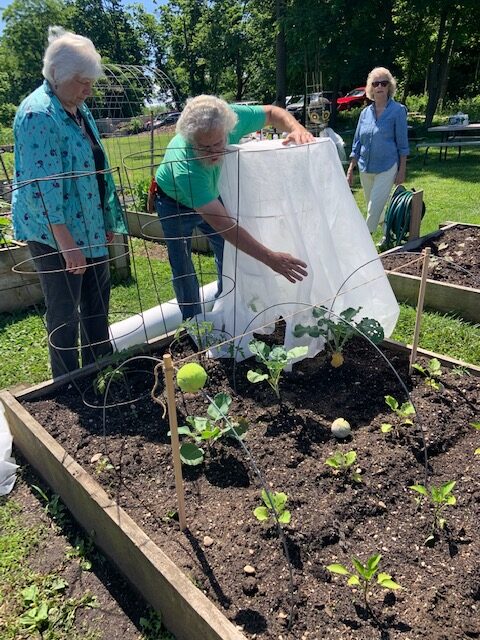Tools you can use

It was a beautiful Saturday morning when Larry and Heather Foglia, co-founders of Gateway Community Garden, came to give a hands-on demonstration of the various organic methods that can protect our vegetables from insect predators. The hand-out, reproduced below, lists the various products and strategies you can use. Most of these products, including a bolt of row cloth that is in the shed, are now available for use on maintenance days and upon request.
Here’s the Handout:
Healthy plants that are appropriately watered and regularly fertilized will often be able to combat garden pests. Controlling insects organically starts with being a keen observer of your vegetable plants as they grow, and engaging in defense, and then, if necessary, offense, as pests begin to cause damage.
Defense:
- Your best defense is to keep a careful eye on your plants, examining the tops and undersides of leaves every time you tend your garden. Many pests lay their eggs on the undersides of leaves. You can gently fold a leaf over the eggs and smash/squeeze them with your fingers. If they have hatched into larvae, sub-adult or even matured into adults, you can squash them as well or push them into some soapy water in a container to drown them. It is easy to catch Japanese Beetles in the evening on your plants, especially eggplant, and drown them this way.
- Protect your plants from insects with physical barriers. For example, flea beetles make holes in the leaves of bokchoy, arugula and eggplant. You can block their access with a cloth cover (floating row cover) that you suspend over hoops or over a ‘tomato cage’. Use clothes pins to hold the cloth to the tomato cage and weigh down the bottoms with stones or bricks.
- Use sticky traps with attractant lures to catch cucumber beetles, squash vine borers, white flies and aphids. These are reasonable priced and are available from Arizona Biological Control, Inc. and can be ordered online at https://www.arbico-organics.com/.
- Cover plant leaves with food-grade diatomaceous earth (available at www.diatomaceousearth.com) or a clay product like Surround WP. These must be applied to the leaves of the plants and then reapplied after rain. Diatomaceous Earth is applied with a hand-held ‘duster’. Surround is used as either a pre-plant dip or sprayed with a hand held spray-bottle. You will need to wear eye protection and a mask to avoid contact with these products, although they are not toxic.
- Squash vine borers can be poked through the stem with thin sharp wire to kill the larvae of the moth that has laid the egg. The stem can then be covered with soil to hopefully allow new roots to grow in that area. You can also periodically cover parts of the spreading stems with soil so there are many rooting sections, preventing a borer from killing a whole plant.
- The whole community garden area can be treated with predatory nematodes at least twice a season. These will eliminate many insects that over winter or spend time in and on the soil. They are also available from www.arbico-Organics.com.
Offense: In general, do not go on offense unless you are seeing damage to your vegetables or begin to see some evidence of a population beginning, such as aphids on the underside of the leaves; or of the adult stage flying around laying eggs, such as the white butterflies/moths whose ‘cabbage worm’ caterpillar stage eats broccoli, kale, cabbage, and such. The three items below can be used as preventative sprays to limit the population growth.
- Insecticidal soap. Cheap, safe and effective against soft-bodied insects including aphids, whiteflies, spider mites, and mealybugs. This product will also smother the eggs of the above insects. Insecticidal soaps also have a beneficial effect in the removal of sooty mold and other leaf fungi because the mold grows on the excretions of the insects. Eliminate the insects and you can then wash off the mold. Must be used weekly, carefully spraying both the tops and the undersides of the leaves, to keep the bug population down. You can make your own (https://www.gardeningknowhow.com/plant-problems/pests/pesticides/homemade-soap-spray.htm) but since home ingredients vary, it is safer to buy it ready-to-use.
- Spinosad. Made from a soil bacterium that can be toxic to insects. It controls a wide variety of pests including thrips, leaf miners, spider mites, caterpillars and foliage-feeding beetles. Many insecticidal products can be combined. Spinosad can be purchased ready-to-use and already mixed with insecticidal soap. Home Depot sells a mix as Insecticidal Super Soap for $10.
- Bt. Bacillus thuringiensis (Bt) is a soil-borne bacteria that has been used since the 1950s for natural insect control. It is effective on cabbage worms, tomato hornworm, tent caterpillars, mosquitoes, black fly and a variety of other insect pests. Bt is available under many labels such as DiPel. Look carefully at the ingredients on the label. As they treat many of the same insects, Bt and Spinosad are usually alternated weekly rather then combined. BT will not harm pollinators but is toxic to Monarch butterfly caterpillars
N.B. Gateway Garden is a Monarch Butterfly Sanctuary. Gardeners with beds near plantings of milk weed (the sole food source for Monarch caterpillars) should be especially careful not to allow spray or drift of the above products, Spinosad or Bt, to go onto the Milkweed.
Other Smart tips
Tomatoes: Blossom End Rot is a condition in which the bottom of the tomato—the end away from the stem where the flower was—turns soft and then black and rots. It is caused by a calcium deficiency in the soil and the plant. Test your soil so the PH is between 6.5 and 7.5. To prevent it, when planting tomato seedlings, you can crush or dissolve a Tums (which contain calcium) and put or water into the soil around the plants. Also make sure the tomatoes receive 1” inch of water per week so the plant can send calcium to the fruit, and mulch to keep the soil moist. You can also spray a product like Bonide Rot Stop, a source of calcium, on the tomato plant leaves after heavy rain or rapid growth. This can also be used on cucumbers, melon and peppers as well. You can also save your eggshells, bake them for a while at 250-300 degrees to sterilize them, grind them to a powder in a food processor, and regularly sprinkle them on your soil to eventually release calcium.
Some plant diseases, caused by bacteria and virus in the soil, can be mitigated by covering the soil around your plants with a layer of straw, leaves or pine-shaving mulch to minimize splash from rain or watering.
Severe infestations of insects and be treated with stronger organic products containing Pyrethrum and/or Azadirachtin (active component of Neem Oil), which can be combined with Insecticidal Soap. Caution must be taken when using these products, and label directions must be carefully followed, as they are very toxic to bees and other pollinators. They must be used very early in the day or very late into the evening when those pollinators are not active. However you can sometimes find bumble bees sleeping for the night in or on some large flowers is the dew sets early and makes it difficult for them to fly.
Keep a record of when you spray, with what, and how it works.
Content Courtesy of Lawrence Foglia, Fox Hollow Farm

